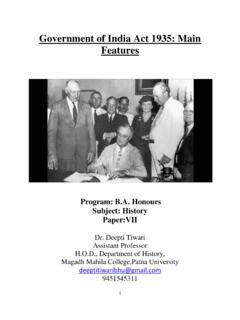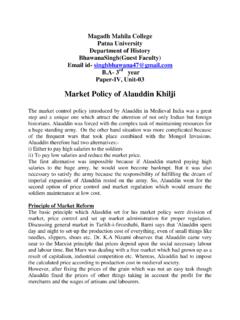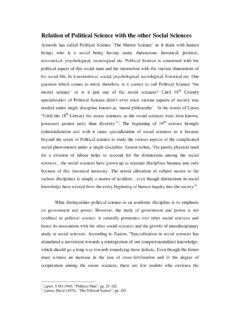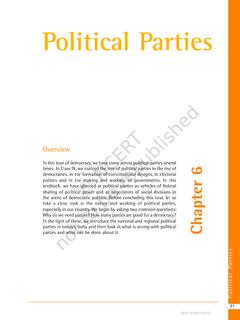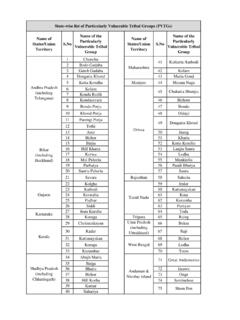Transcription of Government of India Act 1935: Main Features
1 1 Government of India Act 1935: main Features Program: Honours Subject: History Paper:VII Dr. Deepti Tiwari Assistant Professor , Department of History, Magadh Mahila College,Patna University 9451545311 2 Introduction The Government of India Act of 1935 marked the second milestone towards a completely responsible Government in India after the Act of 1919. This Act was passed by the British Government in the year 1935. It was one of the lengthiest Acts at that time as it contained 321 sections and 10 schedules. It was also the last constitution of British India , before the country was divided, in 1947, into two parts- India and Pakistan.
2 Once the act was passed the Government saw that it was too lengthy to be regulated with efficiency and thus, the Government decided to divide it into two parts for the act to function in a proper manner: 1. The Government of India Act, 1935 2. The Government of Burma Act,1935 Background The Government Act of 1919 was not satisfactory at all and was too short in its provisions for the self- Government form to be imposed in the country. There was a growing demand for constitutional reforms in India by Indian leaders. Indian politicians were frustrated at that time because they thought that the area they had officially control over was still in the hands of the British officials with full control over it.
3 So the task to review this matter and to make changes in it had been given to the Simon Commission. When the Simon Commission Report came out it was seen that the report was not satisfactory which would lead to the consultation with the then Indian Community Representatives at the Round Table conference, held in London. 3 The matter was important and was discussed in the round tables of 1930, 1931, and 1932 respectively. The discussion at the Third Round Table Conference resulted in a White Paper in 1934 containing proposals incorporated in a Bill and presented to the Parliament for passage. This came to be known as the Government of India Act of 1935 and was passed by the British Parliament.
4 Thus the Act was based on: Simon Commission Report The recommendations of the Round Table Conferences The White Paper published by the British Government in 1933 (based on the Third Round Table Conference) Report of the Joint Select Committees. Salient Features of the Act- This Act gives many salient Features out of which some has been considered as the major ones and some as the minor ones. These salient Features are given below: 1. All India Federation- The Act provided for an All- India Federation comprising the British Indian Provinces and the Indian States. The terms on which a state could join the federation were mentioned in the Instrument of Accession.
5 It was at the discretion of the state whether it wanted to join the federation that was given by the Government of India Act, 1935. 6 Chief Commissioner s provinces, 11 Governor s provinces and some states who agreed to merge in the stated federation were constituent units of that federation. Every unit enjoyed full autonomy in its internal affairs. According to this act, India would become a federation if 50% of Indian 4 states decided to join it. However, the provisions with regards to the federation were not implemented as the required number of princely states did not join it.
6 2. Provincial Autonomy- One redeeming feature of the new Act was that it marked the beginning of the Provincial Autonomy. It was definitely an advance on the Act of 1919. The provinces were allowed to act as autonomous units of administration in their defined spheres. Moreover, the Act introduced responsible governments in provinces, that is, the governor was required to act with the advice of ministers responsible to the provincial legislature. This came into effect in 1937 and was discontinued in 1939. This, however, does not mean that the Act of 1935 established a full-fledged responsible Government in the Provinces.
7 The Ministers were not absolutely free in matter of running their departments. The Governors continued to possess a set of overriding powers although such powers were not exercised very often. 3. Division of Subjects- The approach to form the federation and implement provincial autonomy paved the way for the division of subjects between the Centre and the Provinces. The division of subjects that were given by the Government of India Act, 1919 was revised and added some more subjects in it by this Act of 1935 and included three lists. These were: Federal list- 59 items Provincial list- 54 items Concurrent list- 36 items 5 The subjects which were of all- India interest and demanded uniform treatment were put in the Federal list.
8 Only the Federal Legislature could make laws on the Federal subjects. Subjects of mainly of local interest were placed the Provincial list and were wholly within the jurisdiction of the Provincial Legislatures for the purpose of legislation. The third list known as the Concurrent list, and which contained 36 items, included subjects which were primarily Provincial interest but at the same time required uniformity of treatment all over the country. Hence, the Act authorised both the Federal and Provincial Legislatures to pass laws on those subjects. In the event of a conflict, the Federal law was to prevail.
9 In order to resolve this point of conflict, the Constitution authorised the Governor General to allocate in his discretion the right to legislate on any subject, not included in the lists, either the Centre or the province. 4. Dyarchy at the Centre- The Act of 1935 abolished dyarchy at the Provincial level and introduced it at the Centre. There were two categories of federal subjects: Reserved subjects Transferred subjects. Reserved Subjects The subjects that are mentioned in this category of federal subjects were to be administered by the Governor-General on the advice of the Executive Councillors and the Executive Council could not exceed its limit of three members.
10 Religious affairs, defense, administration of tribal areas and external affairs were included in the reserved subjects. 6 Transferred Subjects This subject was to be administered on the advice of ministers and the number of ministers could not exceed 10. Subjects other than reserved were dealt with under the Transferred Subjects. The Governor-General remained over all in charge of both the Reserved and Transferred subjects. He was also responsible for the co-ordination of work between the two wings and for encouraging joint deliberations between the councillors and the Ministers. The idea of dyarchy was imposed so that better administration could be done and the governor general was appointed to look after and coordinate among the two parts of the Government .
